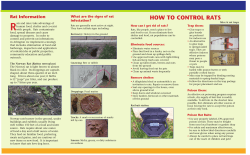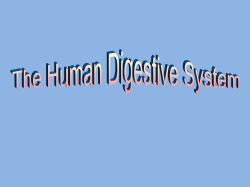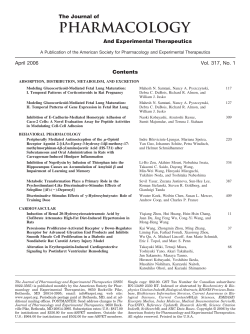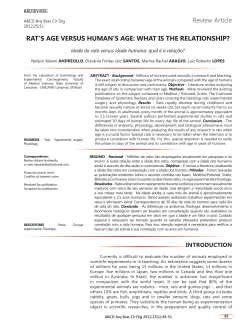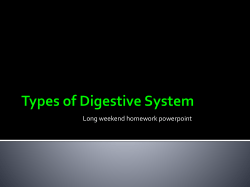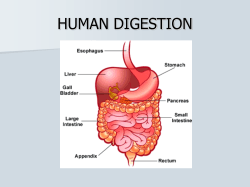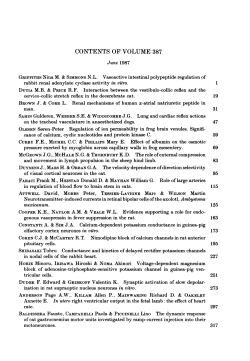
Document 393779
Journal of Cancer Research and Treatment, 2014, Vol. 2, No. 3, 55-63 Available online at http://pubs.sciepub.com/jcrt/2/3/3 © Science and Education Publishing DOI:10.12691/jcrt-2-3-3 The Effect of L-carnitine on Amethopterin-induced Toxicity in Rat Large Intestine Ehab Tousson*, Mona Hegazy, Ezar Hafez, Alaa Abdullah Ahmed Zoology Department, Faculty of Science, Tanta University, Tanta, Egypt *Corresponding author: toussonehab@yahoo.com Received October 15, 2014; Revised October 31, 2014; Accepted November 02, 2014 Abstract Background: Amethopterin is a folic acid antagonist which used as a chemotherapeutic agent and its anti-oxidant activity is used to treat many cancer types. This study aimed to determine the possible protective effects of L-carnitine against Amethopterin induced large intestine toxicity. Methodology: A total 60 male albino rats were equally divided into six groups; the first and second groups were the control and L-carnitine groups respectively while the 3rd group was Amethopterin rat group; the 4th and 5th groups were co- and post- treated Amethopterin rat with L-carnitine respectively and the 6th group was self treated Amethopterin rat group. Results: Glutathione, catalase and total protein levels in Amethopterin and self-treated groups showed a significant decrease when compared with control group, while MDA levels in Amethopterin and self-treated groups showed a significant increase when compared with control group. Many of abnormalities as colonic epithelial cell damage in the form of epithelial separation, cellular loss, congestion of blood vessels, crypt hyperplasia and focal depletion of goblet cells were detected in large intestine tissues in Amethopterin rat group (Amethopterin and self-treated groups). A significant increase of the apoptotic protein p53 and a significant decrease in the antiapoptotic Bc1-2 proteins after Amethopterin injection when compared with control group was observed. Conclusions: Treatment (Co- and post-) with L-carnitine were improved the biochemical, histopathological and immunohistochemical alterations in large intestine that treated with Amethopterin. Keywords: Amethopterin, large intestine, L-carnitine, oxidative stress, apoptotic markers, P53, Bcl2 Cite This Article: Ehab Tousson, Mona Hegazy, Ezar Hafez, and Alaa Abdullah Ahmed, “The Effect of Lcarnitine on Amethopterin-induced Toxicity in Rat Large Intestine.” Journal of Cancer Research and Treatment, vol. 2, no. 3 (2014): 55-63. doi: 10.12691/jcrt-2-3-3. 1. Introduction Amethopterin (methotrexate, MTX) is a folic acid antagonist which used as a chemotherapeutic agent and its anti-oxidant activity is used to treat many cancer types [1,2,3,4]. Amethopterin inhibits dihydrofolate reductase, which is an essential enzyme for DNA and RNA synthesis. One of the most common limiting factors preventing further dose escalation of Amethopterin is gastrointestinal toxicity [5,6,7]. Amethopterin enters the cell via active transport across the reduced folate carrier and is effluxes from the cell by several of the ATP-binding cassette transporters [8]. There are other synonyms for Amethopterin such as Metatrexate, Metatraxan, Mexate, Rheumatrex, Trexall, Abitrexate, Antifolan, Folex, Tremetex. Oxidative stress is known to appear because of an imbalance between the production and degradation of ROS in tissues. ROS-induced injury is well characterized and includes DNA base oxidation, lipid peroxidation, and protein oxidation [9]. Levels of both enzymatic and nonenzymatic anti-oxidants are inhibited and the levels of oxidants increase in the heart, testes, liver, kidney, lung and gut tissues of laboratory animals given Amethopterin [4,6,10-16]. Since the cytotoxic effect of Amethopterin is not selective for cancer cells, it also affects the normal tissues that have a high rate of proliferation, including the hematopoietic cells of the bone marrow and the actively dividing cells of the gut mucosa. Thus, one of the major toxic effects of Amethopterin is intestinal injury and enterocolitis [6]. L-carnitine (4-N-trimethylammonium-3-hydroxybutyric acid) is a natural nutrient that transports long-chain fatty acids into the mitochondria, where they are oxidized to produce adenosine triphosphate and prevent the toxic accumulation of long-chain fatty acids [17-22]. Recent studies suggest that L-carnitine may play an important role in oxidative/antioxidative balance and has an antiperoxidative effect on several tissues [4,21,22,23,24]. Therefore, the present study aimed to study the protection and ameliorating role of L-carnitine in the physiological, histopathological and immunohistochemical altrations in Amethopterin induced large intestine toxicity in male rat. 2. Materials and Methods 2.1. Animals The experiments were performed on 60 male albino rats weighing 140 -150 gm and of 9-10 week’s age. They were Journal of Cancer Research and Treatment obtained from our laboratory farms, Zoology Department, Faculty of Science, Tanta University, Egypt. The rats were kept in the laboratory for one week before the experimental work and maintained on a standard rodent diet (20% casein, 15% corn oil, 55% corn starch, 5% salt mixture and 5% vitaminzed starch; Egyptian Company of Oils and Soap Kafr-Elzayat Egypt) and water available ad labium The temperature in the animal room was maintained at 23±2°C with a relative humidity of 55±5%. Light was on a 12:12 hr light -dark cycle. The experimental protocol was approved by Local Ethics Committee and Animals Research. 2.2. Animal Grouping Sixty rats were equally divided into six groups (10 animals each). G1: Control group in which animals did not received any treatment. G2: L-carnitine or positive control group in which animals received L-carnitine (Mepaco Co., Egypt; 500 mg/Kg body weight/day) orally by stomach tube for four weeks according to Sener et al. and Salama et al [6,22]. G3: Amethopterin group in which rats were injected intraperitoneally with Amethopterin (Ebewe Co., Egypt; 0.5 mg/kg body weight/twice a week) for four weeks according to AL-Motabagani and Tousson et al [4,25]. G4: Co-treated group in which animals were injected intraperitoneally with Amethopterin (0.5 mg/kg body weight/twice a week) plus received orally L-carnitine (500mg/Kg body weight/day) for four weeks. G5: Post-treated group in which animals were injected intraperitoneally with Amethopterin (0.5 mg/kg body weight/twice a week) for four weeks and then treated orally with l-carnitine (500 mg/Kg body weight/day) for another four weeks. G6: Self-treated rat group in which rats were injected intraperitoneally with Amethopterin (0.5 mg/kg body weight/twice a week) for four weeks and left for another four weeks without receiving any treatment. 2.3. Preparation of Tissue Homogenates At the end of the experimental period, rats were fasted overnight and for clinical chemistry. Rats were and weighed and euthanized with intravenous injection with sodium pentobarbital and subjected to a complete necropsy. After scarification of rats large intestine was quickly removed and weighed after removed any debris from tissues carefully. Specimens were separated into two parts. Each piece was weighed and homogenized separately with a 3 Potter Elvenhjem tissue homogenizer. One part was homogenized in phosphate buffer (pH 7.0) for estimation of protein content and catalase enzymes activities levels; the second was 10% w/v large intestine homogenate in ice-cold saline for estimation of MDA and GSH levels. The crude tissue homogenate was centrifuged at 11,739 g, for 15 minutes in a cold centrifuge, and the resultant supernatant was used for different estimations. 2.4. Enzymatic Antioxidant Assays and Non-enzymatic Catalase: The catalase (CAT) activity was measured by monitoring H2O2 (The substrate of the enzyme) 56 decomposition at 240 nm according to the method described by Aebi [26]. MDA assay: Malondialdehyde (MDA), a noxious product of lipid peroxidation, was detected by TBARS analysis and measured as reported by Saggu et al. [27]. The MDA results were expressed as the nmol/mg protein. Reduced GSH: GSH content was determined with dithionitrobenzoic acid using the method described by Beutler et al. [28] and was expressed in μmol GSH/mg protein. The method is based on the reduction of DTNB to produce a yellow compound. The reduced chromogen is directly proportional to GSH concentration and its absorbance can be measured at 412 nm. Total protein: Total protein content in tissue homogenate was measured according to the method of Lowry et al [29]. 2.5. Histopathological Investigation Immediately after decapitation animals were dissected, large intestine from different groups were quickly removed, washed in 0.9 saline solutions and simples of large intestine were fixed in 10 % neutral buffered formalin. After fixation, specimens were dehydrated in an ascending series of alcohol, cleared in two changes of xylene and embedded in molten paraffin (mp. 50–58°C). Sections of 7 microns thickness were cut using rotary microtome and mounted on clean slides. Sections were stained with Ehrlich's haematoxylin and counterstained with eosin as a routine method after Bancroft and Stevens [30]. 2.6. Immunohistochemical Detection of p53 and Bc1-2 Expression of p53 and Bc1-2 immunoreactivities (p53ir and Bc12-ir) was detected using avidin Biotin Complex (ABC) method [4,31,32]. Paraffin sections (5μm thick) of fixed rat large intestine that mounted on gelatin chromalum–coated glass slides were dewaxed and rehydrated sections were washed in distilled water for 5 min, rinsed in PBST for 10 min and incubated with 10% normal goat serum for 15 min to reduce non-specific background staining. Then, the sections were incubated with anti-rabbit p53 or anti-rabbit Bc1-2 (monoclonal antibody (Dako, 1:80 and 1:2000 respectively) for 1-2 hours at room temperature. The sections after 5 baths in PBST were incubated with biotinylated goat anti-rabbit immuoglobulin (Nichirei, Tokyo, Japan). The sections after 5 baths in PBST were further incubated with Avidin Biotin Complex (ABC: Nichirei, Tokyo, Japan) for 1 hour at RT. The reaction was developed by using 20 mg 3-3´diaminobenzidine tetrahydrochloride (DAB, Wako pure chemical industries, Ltd) in 40 ml PBST, pH 7.2 containing 10 ml of hydrogen peroxide (H2O2) for 7-9 min at a dark room followed by distilled water then dehydrated and mounted. The criterion for a positive reaction confirming the presence of p53 and Bcl-2 is a dark, brownish, intra cytoplasmic precipitate. For the negative control, the primary antibody was omitted to guard against any false positive results which might develop from a nonspecific reaction. Brightness, contrast were adjusted using Adobe Photoshop software. Image analysis was adjusted using PAX-it image analysis software. 57 Journal of Cancer Research and Treatment 2.7. Statistical Analysis Data were expressed as mean values ± SEM and statistical analyses were performed using SPSS statistical version 16 software package (SPSS® Inc., USA). The criterion for statistical significance was set at p<0.01. 3. Results 3.1. Toxicity The animals under practice appeared healthy and show no clinical signs of disease and mortality was recorded during the exposure to L-carnitine. Various side effects were observed in animals treated with Amethopterin such as 4% mortality, loosing of body weight, loss of activity, weakness, yellowish body hair, diarrhea and bleeding around eyes. 3.2. Biochemical Investigations Figure 1 shows that; MDA levels in Amethopterin group (G3) showed significant increase when compared with control (G1) and L-carnitine (G2) groups. On the other hand, glutathione (GSH), total protein and catalase levels in Amethopterin group (G3) showed significant decrease when compared with control (G1) and Lcarnitine (G2) groups. In contrast, MDA levels in treated Amethopterin group with L-carnitine group (G4&G5) were significantly decreased when compared with Amethopterin group (G3) while GSH, total protein and catalase levels in treated Amethopterin group with Lcarnitine group (G4&G5) were significantly increased when compared with Amethopterin group (G3). MDA levels in co-treated Amethopterin group with L-carnitine group (G4) were significantly decreased when compared with post treated Amethopterin group with L-carnitine group up (G5) while GSH, total protein and catalase levels in co-treated Amethopterin group with L-carnitine group (G4) were significantly increased when compared with post treated Amethopterin group with L-carnitine group up (G5). On the other hand, Glutathione, total protein and catalase levels in self-treated group (G6) showed significant decrease when compared with Amethopterin group (G3) while, MDA levels in self-treated group (G6) showed significant increase when compared with Amethopterin group (Figure 1). Figure 1. Changes in MDA, GSH, total protein and catalase levels in large intestine in different groups under study. Data are expressed as mean ± S.E.M of 10 observations. Significant difference from the control group (G1) at *p<0.05. Significant difference from Amethopterin group (G3) at # p<0.05. Where G1, Control group; G2, L-carnitine group; G3, Amethopterin group; G4, Co-treated Amethopterin group with L-carnitine; G5, Posttreated Amethopterin group with L-carnitine; G6, Self-treated Amethopterin group 3.3. Effect of Amethopterin on Histopathology On Large Intestine Examination of sections stained with H & E showed no differences in colonic mucosal structure between control (G1) and L-carnitine (G2) groups, all of which showed normal histological appearance (Figure 2A & Figure 2B). The colonic mucosa showed normal intestinal crypts lined by epithelial columnar cells and goblet cells. The lamina propria contained few mucosal mast cells full of cytoplasmic granules (Figure 2A & Figure 2B). Light microscopy of the rat large intestine sections in Amethopterin group (G3) raveled colonic epithelial cell damage in the form of epithelial separation, cellular loss, congestion of blood vessels, crypt hyperplasia and focal depletion of goblet cells as well as mononuclear cellular infiltration in lamina propria. These inflammatory cells included macrophages, fibroblasts, and plasma cells Journal of Cancer Research and Treatment (Figure 2C). Co-treatment of Amethopterin rats with Lcarnitine for four weeks revealed more or less normal mucosal structure with a few inflammatory cells and mild congestion of blood vessels (Figure 2D). Large intestine sections on post-treatment of Amethopterin rats with L- 58 carnitine revealed mild to moderate colonic epithelial cell damage, atrophy and mild crypt hyperplasia (Figure 2E). Large intestine sections of self treated rats revealed severe tissue injury as marked colonic epithelial cell damage and strong congested blood capillaries (Figure 2F). Figures 2(A-F). Photomicrographs of the rat large intestine sections stained by HE. A&B: Micrographs from control and L-carnitine groups revealed normal structure. C: Micrograph of the large intestine in Amethopterin rat group revealed many of abnormalities as colonic epithelial cell damage in the form of epithelial separation, cellular loss (arrow heads), congestion of blood vessels, crypt hyperplasia and leukocyte infiltration (arrows). D: Micrograph of the large intestine in Co-treatment of Amethopterin rats with L-carnitine revealed more or less normal mucosal structure with a few cellular loss (arrow heads), a few inflammatory cells and mild congestion of blood vessels. E: Micrograph of the large intestine in post treatment of Amethopterin rats with L-carnitine revealed mild to moderate colonic epithelial cell damage, atrophy and mild crypt hyperplasia. F: Micrograph of the large intestine in self treatment revealed severe tissue injury as marked colonic epithelial cell damage and strong congested blood capillaries 3.4. Immunohistochemical Examination of Large Intestine Tissue 3.4.1. P53 Immunoreactivity in Rat Large Intestine Figure 3A - Figure 3F) and Table 1 showed the detection and distribution of p53 immunoreactivity (P53-ir) in the large intestine in the different groups under study. P53 is a nuclear phosphoprotein which acts as a tumor suppressor. Large intestine in control and L-carnitine groups showed finite reaction for p53-ir (grade 1). Severe positive reaFigure ctions for p53-ir (grade 4) were detected in Amethopterin and self- Amethopterin treated rat groups (Figure 3A - Figure 3C, Figure 3F). Moderate (grade 3) to mild (grade 2) positive reactions for p53-ir were observed in the large intestine in Co-treated and post-treated rats with L-carnitine (Figure 3D & Figure 3E) respectively. 59 Journal of Cancer Research and Treatment Figures 3(A-F). A-F High power micrographs of the rat large intestine stained by P53-ir. A&B: Negative or faint p53-ir reaction in control and Lcarnitine respectively. C: Severe positive reactions for p53-ir in Amethopterin group. D&E: Moderate to mild positive reactions for p53-ir in Co-treated and post treated rats with L-carnitine respectively. F: Moderate positive reaction for p53-ir in self treated rats 3.4.2. Bcl2 Immunoreactivity in Rat Large Intestine Figure 4A - Figure 4F) and Table 1 show the detection and distribution of Bcl2-ir immunoreactivity (Bcl2-ir) in the large intestine tissues in the different groups under study. large intestine in control and L-carnitine groups showed marked positive reaction for Bcl2-ir (grade 4) as in Figure 4A & Figure 4B). Mild positive reactions for Bcl2-ir (grade 1) were detected in the large intestine sections in Amethopterin rat group (Figure 4C). The intensity of Bcl2-ir in the rat large intestine sections in Amethopterin group was significantly decreased when compared with control rat. Moderate (grade 3) to mild (grade 2) positive reactions for Bcl2-ir were observed in the large intestine in co-treated and posttreated rats with L-carnitine (Figure 4D & Figure 4E) respectively. On the other hand; the intensity Bcl2-ir were stay mild to moderate positive reaction (grade 2) in selftreated large intestine sections when compared with treated Amethopterin rats with L-carnitine groups (Figure 4F). Table 1. Changes in P53 and Bcl2 expressions in large intestine sections in different groups under study P53 Bcl2 G1 1 4 G2 1 4 G3 4 1 G4 3 3 G5 2 2 G6 3 2 Data are expressed as mean ± S.E.M of 5 observations. G1, Control group; G2, L-carnitine group; G3, Amethopterin group; G4, Co-treated Amethopterin group with L-carnitine; G5, Post-treated Amethopterin group with L-carnitine; G6, Self-treated Amethopterin group. where 0, Negative reaction; 1, light reaction; 2, mild reaction; 3 moderate reaction; 4, strong reaction. Journal of Cancer Research and Treatment 60 Figures 4(A-F). A-F High power micrographs of the rat large intestine stained by Bcl2-ir. A&B: Severe positive Bcl2-ir reaction in control and Lcarnitine respectively. C: Faint to mild positive reactions for Bcl2-ir in Amethopterin group. D&E: Moderate to mild positive reactions for Bcl2-ir in Co-treated and post treated rats with L-carnitine respectively. F: Mild positive reaction for Bcl2-ir in self treated rats 4. Discussion Chemotherapy commonly produces structural and functional damage to the intestinal mucosa in cancer patients [33] and in patients with rheumatoid arthritis [34]. Amethopterin (MTX), is an antineoplastic agent used to fight a number of different cancers, such as acute lymphoblastic leukemia and solid cancers, due to its inhibitory effect on de novo purine and pyrimidine synthesis through dihydrofolate reductase inhibition [35]. On the other hand, substantial evidence supports the concept that Amethopterin was mutagenic and carcinogenic in animals. And the efficacy of this compound is often limited by its severe gastrointestinal toxicity [6,7,36,37,38]. Amethopterin is recognized as the most effective of the traditional disease modifying antirheumatic drugs but it has several toxicities. This study conducts a biochemical, histopathological and immunohistochemical investigation into whether Lcarnitine has a protective and ameliorated effect on Amethopterin -induced large intestine damage in male rats. The results of the studies indicate that Amethopterin causes oxidative tissue damage by increasing lipid peroxidation in the large intestine tissues and decreasing the level of antioxidant enzymes. Moreover, the histopathological and p53 and Bcl2 alterations supported this conclusion. It has also been shown that L-carnitine given for 28 days with or after the Amethopterin application provided significant protection from the large intestine damage of Amethopterin. In current study, there was a significant. Many aspects of the pathophysiology are mediated by oxidative stress [20,39,40]. In the present study, Amethopterin significantly altered the oxidant/antioxidant balance. In the current study, MDA levels in Amethopterin group were significantly increased unlike 61 Journal of Cancer Research and Treatment glutathione, catalase and total protein levels which were significantly decreased when compared with control group. So, Amethopterin increased MDA level accompanied with decreased GSH content and CAT activities. Similar results were previously reported by other investigators [10,41]. Oxidative stress or oxidative cellular damage with its dual of free radical generation and profound lipid peroxidation are hallmarks of Amethopterin toxicity [42]. Amethopterin induces oxidative stress in tissues as demonstrated by increasing MDA levels [10,11]. MDA, as an end product of lipid peroxidation, usually used to estimate the extent of lipid peroxidation. The high level of MDA in the Amethopterin and self-treated groups in large intestine tissues indicates that Amethopterin gives rise to oxidative stress in colonic tissue. Our current results agree with Vardi et al. [43] who reported that, oxygen radicals and hydrogen peroxides have been associated with the many side effects of Amethopterin and these free radicals trigger cell damage through binding to cellular macromolecules. It has been shown that many pathological conditions that resulted in elevation of MDA due to lipid peroxidation were prevented by L-carnitine [44,45]. The increase lipid peroxidation responsible for the formation of lipid hydroperoxides. GSH is considered to be one of the most very important components of the antioxidant defense of living cells. The reduced tri-peptide GSH is a hydroxyl radical and singlet oxygen scavenger, and participates in a wide range of cellular functions [15]. Actually, the nadir in colonic GSH content promoted by Amethopterin represents an alteration in the cellular redox state, suggesting that the cells could be more sensitive to reactive oxygen metabolites and leads to a reduction in the effectiveness of the antioxidant enzyme defense system [46,47]. Also in the same way and supported for earlier results; GSH, total protein and catalase levels in self treated group showed significant decrease when compared with Amethopterin group while, MDA levels in self-treated group showed significant increase when compared with Amethopterin group. Our results not agreed with Ciralik et al. [48] who observed an increase in reduced glutathione levels, also observed increased activities of catalase of the tissue induced by Amethopterin. Catalase acts as a preventative antioxidant whereas it catalyses the reduction of H2O2 and plays an important role in protection against the deleterious effects of lipid peroxidation, ROS and hydroxyl radicals caused by Amethopterin administration [13]. In the present study, increase in the lipid peroxidation activity due to toxic effects of Amethopterin was accompanied by significant reduction in reduced GSH level of the large intestine tissue, indicating the presence of oxidative tissue damage. lipid peroxidation, mediated by oxygen free radicals is believed to be an important cause of destruction and damage to cell membranes [6,49]. Our results showed that L-carnitine exhibited anti-oxidant effects not only on the non enzymatic defense system (GSH), but also on the enzymatic one such as catalase. Treatment with L-carnitine following Amethopterin apparently increased GSH content and increased catalase activities compared to Amethopetrin treated animals. Data so far obtained from this study would suggest that administration of L-carnitine after Amethopterin challenge may have beneficial effects that could possibly be ascribed, in part, to its regulation of the oxidant/anti-oxidant balance. These results were supported by our histopathological findings. Due to its high turnover rate, the epithelium of gastrointestinal tract is susceptible to chemotherapyinduced damage, leading to the destruction of intestinal mucosa barrier and subsequent clinical manifestations [38,50]. In the current study, many abnormalities were reported in the large intestine in Amethopterin group. This alterations as colonic epithelial cell damage in the form of epithelial separation, cellular loss, congestion of blood vessels, crypt hyperplasia and focal depletion of goblet cells. The mechanism by which Amethopterin causes large intestine damage results from binding to the enzyme dihydrofolic reductase, thus preventing conversion of folic acid to its active form, folinic acid. This in turn blocks the synthesis of nucleic acids, certain amino acids and indirectly proteins. This might lead to damage of organelles and plasma membranes with their function and allowing leakage of enzymes. Protective mechanisms of L-carnitine include the inhibition of mitochondrial membrane permeability, as transition, the decrease of oxidative stress, and the prevention of pro-apoptotic protein expression [20]. It was also reported that antioxidant properties of Lcarnitine may be related to the transport of fatty acids into mitochondria for β-oxidation and thus to the decrease of lipid usage and protection of the cell membrane against toxic reactive oxygen species (ROS) and other free radicals [51]. Our results presented in this study show similarity with the findings of previous studies on the antioxidant effects of L-carnitine [52,53]. Apoptosis, or programmed cell death, is a crucial cellular activity in the behavior of mammalian cells in a wide range of pathophysiological conditions. There are numerous external signals that are involved in the regulation of the apoptosis; p53 is the one of most extensively investigated pathways [4,54,55,56]. Immunohistochemical observations of the large intestine tissues showed a significant increase of the apoptotic protein p53 and a significant decrease in the antiapoptotic Bc1-2 proteins after Amethopterin injection. An inverse correlation was found between the expression of Bcl-2 and p53 proteins in our results. Similar bidirectional changes of protein expression patterns of bcl-2 and p53 were also observed by Tousson et al. and Diebold et al. [4,32,57] although Diebold et al. [57] failed to reveal any correlation between the expressions of these two proteins. So, the increasing of p53 apoptotic cells and the decreasing Bcl-2 antiapoptotic cells in the present study reveal the possibility of the apoptosis occurrence after Amethopterin administration. Our results showed that, the expression of bcl-2 increased, cancer cells would resist the apoptosis induced by chemical drugs or radiation during therapy. Amethopterin acts as a dihydrofolic acid analogue that binds to the dihydrofolic acid reductase enzyme by inhibiting the synthesis of tetrahydrofolate, which is required for DNA synthesis [46]. L-carnitine can carry long chain fatty acyl groups into mitochondria for beta-oxidation [58]. We can conclude that co-treatment prevented oxidative damage by inhibiting ROS production and improving antioxidant enzymes. While, post-treatment regulated the oxidant/antioxidant balance and neutralized the toxic side effects caused by Journal of Cancer Research and Treatment Amethopterin induced oxidative stress. Concurrently, cotreatment acted with more effectiveness than posttreatment. Thus, our study provides important evidences for experimental and clinical investigations about the role of the co- and post- ways of treatment against the toxic side effects of Amethopterin therapeutics. Also, we recommend to propose directions for further studies in the near future. [9] [10] [11] [12] Conflicts of Interest [13] The authors had no conflicts of interest to declare in relation to this article. [14] Acknowledgments I thank Prof. Dr. Ahmed Masoud (Zoology dep., Fac. of Science, Tanta Univ., Egypt) for her critical and helpful comments on a draft of this manuscript. List of Abbreviations ABC, Avidin Biotin Complex; FAICAR, formyl AICAR; H&E, Hematoxylin Eosin staining; H2O2, hydrogen peroxide; MDA, Malondialdhyde; RA, Rheumatoid arthritis; S, Serum; S.E.M, Standard Error Mean; TCA, trichloronacetic acid; WBCs, white blood cells; ATP, Adenosine triphosphate; DNA, Deoxyribonucleic acid; RNA, Ribose nucleic acid; ROS, Reactive oxygen species; CAT, catalase; GSH, Glutathione; MTX, Methotrexate; Bcl2-ir, Bcl2 immunoreactivity. References [1] [2] [3] [4] [5] [6] [7] [8] Cronstein BN. Molecular therapeutics. Methotrexate and its mechanism of action. Arthritis Rheum 2004; 39: 1951-60. Kimura E, Nishimura K, Sakata K, Oga S, Kashiwagi K, Igarashi K. Methotrexate differentially affects growth of suspension and adherent cells. Int J Biochem Cell Biol 2004; 36: 814-25. Salzer WL, Winick NJ, Wacker P, Lu X, Devidas M, Shuster JJ. Plasma methotrexate, red blood cell methotrexate, and red blood cell folate values and outcome in children with precursor n Bacute lymphoblastic leukemia:a report from the children’s oncology group. J Pediatr Hematol Oncol 2012; 34: 1-7. Tousson E, Hafez E, Zaki S, Gad A. P53, Bcl-2 and CD68 expression in response to amethopterin-induced lung injury and ameliorating role of l-carnitine. Biomed and Pharmacotherapy 2014; 68: 631-9. Carneiro-Filho BA, Lima IP, Araujo DH, Cavalcante MC, Carvalho GH, Brito GA, Lima V, Monteiro SM, Santos FN, Ribeiro RA, Lima AA. Intestinal barrier function and secretion in methotrexate-induced rat intestinal mucositis. Dig Dis Sci 2004; 49: 65-72. Sener G, Demiralp EE, Etiner M, Ercan F, Yegen BC. Glucan ameliorates methotrexate-induced oxidative organ injury via its antioxidant and immunomodulatory effects. European Journal of Pharmacology 2006; 542: 170-8. Soares PM, Lopes LO, Mota JM, Belarmino-Filho JN, Ribeiro RA, de Souza MH. Methotrexate-induced intestinal mucositis delays gastric emptying and gastrointestinal transit of liquids in awake rats. Arq Gastroenterol 2011; 48: 80-85. Wielinga P, Hooijberg JH, Gunnarsdottir S, Kathmann I, Reid G, Zelcer N, van der Born K, de Haas M, van der Heijden I, Kaspers G, Wijnholds J, Jansen G, Peters G, Borst P. The human multidrug resistance protein MRP5 transports folates and can mediate cellular resistance against antifolates. Cancer Res 2005; 65: 442530. [15] [16] [17] [18] [19] [20] [21] [22] [23] [24] [25] [26] [27] [28] [29] [30] [31] [32] [33] 62 Laskin JD, Black AT, Jan YH, Sinko PJ, Heindel ND, Sunil V, Heck DE, Laskin DL. Oxidants and antioxidants in sulfur mustard-induced injury. Ann N Y Acad Sci 2010; 1203: 92-100. Jahovic N, Cevik H, Sehirli AO, Yˇegen BC, Sener G. Melatonin prevents methotraxate- induced hepatorenal oxidative injury in rats. J Pineal Res 2003; 34: 282-7. Cetin A, Kaynar L, Kocyigit I, Hacioglu SK, Saraymen R, Ozturk A, Sari I, Sagdic O. Role of grape seed extract on methotrexate induced oxidative stress in rat liver. American Journal of Chinese Medicine 2008; 36: 1-12. Hemeida AR, Omar MM. Curcumin Attenuates MethotraxateInduced Hepatic Oxidative Damage in Rats. Journal of the Egyptian Nat. Cancer Inst 2008; 20(2): 141-8. Vardi N, Parlakpinar H, Ozturk F, Ates B, Gul M, Cetin A, Erdogan A, Otlu A. Potent protective effect of apricot and βcarotene on methotrexate induced intestinal oxidative damage in rats. Food and Chemical Toxicology 2008; 46: 3015-3022. Vardi N, Parlakpinar H, Ates B, Cetin A, Otlu A. Antiapoptotic and antioxidant effects of beta-carotene against methotrexateinduced testicular injury. Fertil Steri 2009; 92: 202833. Iyyaswamy A, Rathinasamy S. Effect of chronic exposure to aspartame on oxidative stress in the brain of albino rats. Biosci 2012; 37: 679-88. Ozogula B, Kisaoglua A, Turanb MI, Altunerc D, Senerd E, Cetine N, Ozturk C. The effect of mirtazapine on methotrexateinduced toxicity in rat liver. Science Asia 2013; 39: 356-36. Agarwal A, Said TM. Carnitines and male infertility. Reprod Biomed Online 2004; 8: 376-84. Sinclair C, Gilchrist JM, Hennessey JV, Kandula M. Muscle carnitine in hypo- and hyperthyroidism. Muscle Nerve 2005; 32: 357-9. Ulvi H, Aygul R, Demir R. Effect of L-carnitine on diabetic neuropathy and ventricular dispersion in patients with diabetes mellitus. Turk J Med Sci 2010; 40: 169-75. Chao HH, Liu JC, Hong HJ, Lin JW, Chen CH, Cheng TH. Lcarnitine reduces doxorubicin-induced apoptosis through a prostacyclin-mediated pathway in neonatal rat cardiomyocytes. Int J Cardiol 2011; 146: 145-52. Salama AF, Kasem SM, Tousson E, Elsisy MK. Protective role of L-carnitine and vitamin E on the kidney of atherosclerotic rats. Biomedicine & Aging Pathology 2012; 2: 212-5. Salama A, Kasem S, Tousson E, Elsisy MK. L-carnitine and vitamin E alleviate reproductive toxicity caused by triton WR 1339 in male albino rats. Toxicology and Industrial Health; 2013. Cayir K, Karadeniz A, Yildirim A, Kalkan Y, Karakoc A, Keles M. Protective effect of L-carnitine against cisplatin-induced liver and kidney oxidant injury in rats. Cent Eur J Med 2009; 4: 184-91. Pehlivan M, Coşkun A, Zengin A, Aslaner A, Yavuz T. Does Lcarnitine increase serum TNF -α and IGF-1 during liver regeneration in the rat?. Turk J Med Sci 2009; 39: 875-80. Al-Motabagani MA. Estudios histológico e histoquímico del efecto del metotrexato en el hígado de rata macho albina adulta. Int. J. Morphol 2006; 24(3): 417-22. Aebi H. Catalase. In: Bergmeyer HU, (ed.) Methods of Enzymatic Analysis. New York: Academic Press 1984; pp: 673-84. Saggu S, Kumar R. Modulatory effect of seabuckthorn leaf extract on oxidative stress parameters in rats during exposure to cold, hypoxia and restraint (C-H-R) stress and post stress recovery. J Pharm Pharmacol 2007; 59(12): 1739-45. Beutler E, Duron O, Kelly BM. Improved method for the determination of blood glutathione. J.Lab. Clin. Med 1963; 61: 882-8. Lowry OH, Rosebrough NJ, Farr AL, Randall RJ. Protein measurement with Folin phenol reagent. J Biol Chem 1951; 193: 265-75. Bancroft JD, Stevens GA. Theory and Practice of Histological Techniques. 2nd Ed. Churchill Livingstone, London 1990. Sternberger LA. The unlabelled antibody peroxidaseantiperoxidase (PAP) method. In: “immunocytochemistry”, 2nd edn., (Cohen S, and McClusky RT.ed.). John Wiley and sons, New York 1979; pp: 104-69. Tousson E, Alm-Eldeen A, El-Moghazy M. p53 and Bcl2expression in response to boldenone induced liver cells injury. Toxicology and Industrial Health 2011; 27(8): 711-8. Cunningham D, Morgan RJ, Mills PR. Functional and structural changes of the human proximal small intestine after cytotoxic therapy. J Clin Pathol 1985; 38: 265-70. 63 Journal of Cancer Research and Treatment [34] Phelen MJ, Taylor W, van Heyningen C, Williams E, Thompson [47] Fiocchi C. Inflammatory bowel disease: New insights into RN.Intestinal absorption in patients with rheumatoid arthritis treated with methotrexate. Clin Rheumatol 1993; 12: 223-25. Zhang P, Li J, Liu Y, Chen X, Kang Q, Zhao J, Li W. Human neural stem cell transplantation attenuates apoptosis and improves neurological functions after cerebral ischemia in rats. Acta Anaesthesiol Scand 2009;53(9):1184-91. Nagakubo J, Tomimatsu T, Kitajima M, Takayama H, Aimi N, Horie T. Characteristics of transport of fluoresceinated methotrexate in rat small intestine. Life Sci 2001; 69: 739-47. Kolli RP, Seidman DN. Comparison of compositional and morphological atom-probe tomography analyses for a multicomponent Fe-Cu steel. Microsc Microanal 2007; 13: 272-84. Wardill HR, Bowen JM, Gibson RJ. Chemotherapy-induced gut toxicity: are alterations to intestinal tight junctions pivotal?. Cancer Chemother Pharmacol 2012; 70: 627-35. Rachmilewitz EA, Schrier S. Pathophysiology of β thalassemia. In: Steinberg MH, Forget BG, Higgs DR, Nagel RL, editors. Disorders of Hemoglobin: Genetics, Pathophysiology, and Clinical Management. Cambridge, UK: Cambridge University Press 2001; PP: 233-51. Rund D, Rachmilewitz E. Beta-thalassemia. N Engl J Med 2005; 353: 1135-46. ALL C, Ertan B, Ergul BK, Bulent K. N-acetylcysteine ameliorates methotrexate-induced oxidative liver damage in rats. Med Sci Monit 2006; 12(8): 247-8. Jahovic N, Sener G, Cevic H, Ersoy Y, Arbak S, Yegen BC. Amelioration of methotrexate-induced enteritis by melatonin in rats. Cell Biochem Funct 2004; 22: 169-78. Vardi A, Bosviel R, Rabiau N, Adjakly M, Satih S, Dechelotte P. Soy phytoestrogens modify DNA methylation of GSTP1, RASSF1A, EPH2 and BRCA1 promoter in prostate cancer cells. In Vivo 2010; 24: 393-400. Atila K, Coker A, Sagol O, Coker I, Topalak O, Astarcioglu H, Karademir S, Astarcioglu I. Protective effects of carnitine in an experimental ischemia reperfusion injury. Clin Nutr 2002; 21: 309-13. Derin N, Agac A, Bayram Z, Asar M, Izgut-Uysal VN. Effects of L-carnitine on neutrophil-mediated ischemia-reperfusion injury in rat stomach. Cell Biochem Funct 2006; 24: 437-42. Babiak RM, Campello AP, Carnieri EG, Oliveira MB. Methotrexate: pentose cycle and oxidative stress. Cell Biochem Funct 1998; 16: 283-93. mechanisms of inflammation and increasingly customized approaches to diagnosis and therapy. Curr.Opin. Gastroentrol 2004; 20: 309-10. Ciralik H, Bulbuloglu E, Cetinkaya A, Kurutas EB, Celik M, Polat A. Effects of N acetylcysteine on methotrexate induced small intestinal damage in rats. The Mount Sinai Journal of Medicine 2006; 73: 1086-92. Tarasub N, Junseecha T, Tarasub C, Na Ayutthaya WD. Protective Effects of Curcumin, Vitamin C, or their Combination on Cadmium-Induced Hepatotoxicity. J Basic Clin Pharm 2012; 3: 273-81. Stringer AM, Gibson RJ, Bowen JM, Logan RM, Yeoh AS, Keefe DM. Chemotherapy-induced mucositis: the role of gastrointestinal microflora and mucins in the luminal environment. J Support Oncol 2007; 5: 259-67. Kalaiselvi, T, Panneersalvam C. Effect of L-carnitine on the status of lipid peroxidation and antioxidants in aging rats. J. Nutr. Biochem 1998; 9: 575-81. Atroshi F, Rizzo A, Biese L, Veijalainen P, Saloniemi H, Sankari S, Andersson K. Fumonisin B1-induced DNA damage in rat liver and spleen: Effect of pretreatment with coenzyme Q10, Lcarnitine, α-tocopherol and selenium. Pharmacol. Res 1999; 40: 459-67. Arockia Rani PJ, Panneerselvam C. L-carnitine as a free radical scavenger in aging. Exp. Gerontol 2001; 36: 1713-26. Vaux DL, Strasser A.The molecular biology of apoptosis. Proc Natl Acad Sci USA 1996; 93: 2239-44. Nagatu S. Apoptosis by death factor. Cell 1997; 88: 355-65. Tousson E, Beltagy DM, Abo Gazia M, Al-Behbehani B. Expressions of P53 and CD68 in mouse liver with Schistosoma mansoni infection and the protective role of silymarin. Toxicology and Industrial Health; 2012. Diebold J, Baretton G, Felchner M, Meier W, Dopper K, Schmidt M, Lohrs U. Bcl-2 expression, p53 accumulation, and apoptosis in ovarian carcinomas. Am J Clin Pathol 1996; 105: 341-34. Augustyniak A, Skrzydlewska E. L-carnitine in the lipid and protein protection against ethanol-induced oxidative stress. Alcohol 2009; 43(3): 217-23. [35] [36] [37] [38] [39] [40] [41] [42] [43] [44] [45] [46] [48] [49] [50] [51] [52] [53] [54] [55] [56] [57] [58]
© Copyright 2025
